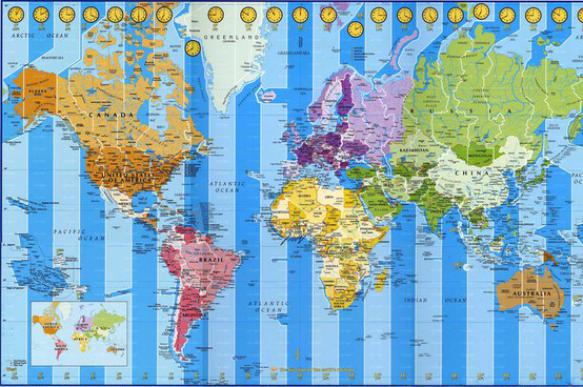Interesting facts about time zones
Fact No. 1: A step 3.5 hours long. Where: The Afghan-Chinese border

When crossing this border, the clock needs to be put 3.5 hours forward at once. There is no other place in the world where one step would take so much time.
Fact No. 2: Sunsets at midnight. Where: China
China is one of the most elongated countries in the world. It stretches for 5,700 km from west to east. Prior to the 1949 revolution, China was divided into five time zones. After the revolution, Beijing time was introduced for the whole nation. In Tibet, for example, the sun "arrives" about five hours late because of the time gap, and the sun sets there when clock shows 12 a.m.
Fact No. 3: The Land of the Rising Sun. Where: The Far East
It is generally believed that Japan is the first country to see the sunrise. This is the reason why Japan is known as the Land of the Rising Sun. As a matter of fact, in the city of Vladivostok (Russia's Far East), morning comes one GMT hour earlier than in Tokyo.
Fact No. 4: Winding time. Where: The Himalayas
The Himalayan mountain range is considered a mystical place for a reason, and even common geographers share this point of view. The Himalayas cross several countries with different time zones. As a result, a traveler, who decided to travel along 1,000 km of the ridge, will have to adjust their time six times: on the Indo-Nepalese border - 15 minutes forward, on the Nepalo-Indian border - 15 minutes back, on the Indo-Chinese border - 2.5 hours forward, on the Sino-Bhutan border - 2 hours back, on the Butano-Indian - 30 minutes back, and on the Indo-Myanmar border - one hour forward.
Fact No. 5: Life without present. Where: International Date Line
This conditional line goes in the Pacific Ocean along the 180th meridian. Crossing the IDL from west to east, you can go back 24 hours back - to "yesterday", whereas when moving from east to west - one goes 24 hours forward - to "tomorrow". Time present is ephemeral in this place.
Fact No. 6: From Thursday to Wednesday. Where: Ratmanov Islands (Russia) and Krusenstern Islands (USA)
These two pieces of land are separated by only four kilometers of the sea. An ordinary motor boat covers this distance in 15-20 minutes. However, there are 21 GMT hours between those islands. If it is a Thursday noon on the Ratmanov Islands, it will be 3 p.m. Wednesday on the island of Krusenstern.
Fact No. 7: Upside down from England. Where: India
India chose a five and a half hour difference with Greenwich. The British know: "If you're in England, turn the clock upside down, and you will know what time it is now in India."
Fact No. 8: The collision of three time zones. Where: The border of Finland, Norway and Russia
In the small village of Rajakoski located on the border of those three states, three time zones collide, when it is noon in Russia, 11:00 a.m. in Finland, and 10 a.m. in Norway.
Fact No. 9: 15-minute independence. Where: Nepal
The small, but proud state of Nepal had been trying to separate from from India for centuries. India surrounds Nepal from three sides. To emphasize its independence, Nepal first "separated" from the formidable neighbor in time: Nepal set the clock ten minutes forward. In 1986, the arrogant Nepalese monarchy set its clock five more minutes forward.
Fact No. 10: World time. Where: At North and South Poles
At North and South Poles, all meridians converge to a point, so they can not be attributed to any time zone. Therefore, it is commonly believed that it is universal time on the poles of the planet (according to Greenwich Mean Time). However, the US Antarctic station Amundsen-Scott, located right on the South Pole, lives by the time of New Zealand, because the latter has flight connection with the station.
Renata Shishkina
Yoki.ru
Subscribe to Pravda.Ru Telegram channel, Facebook, RSS!


